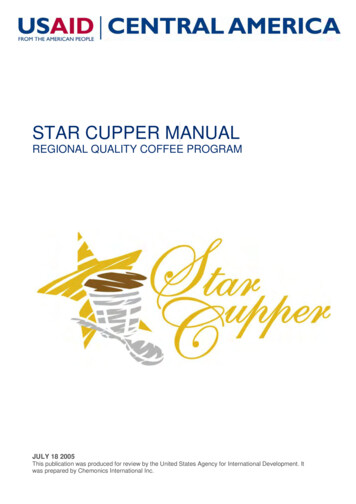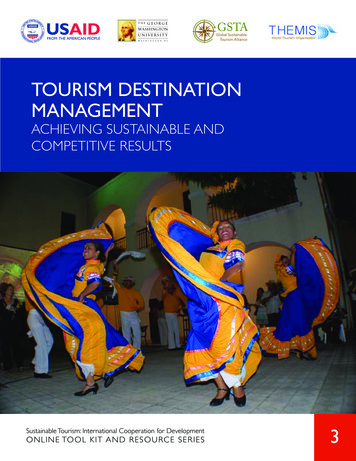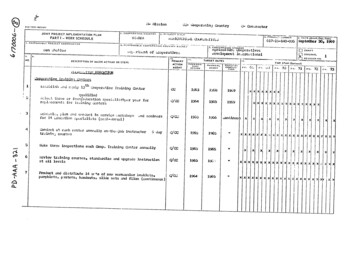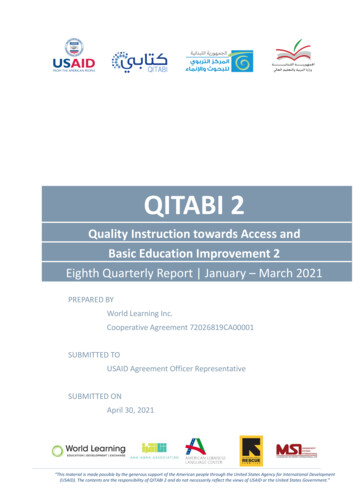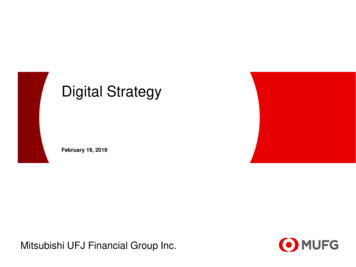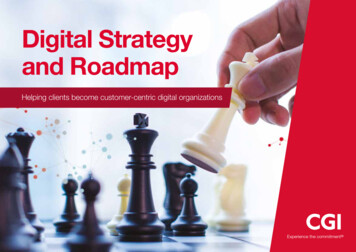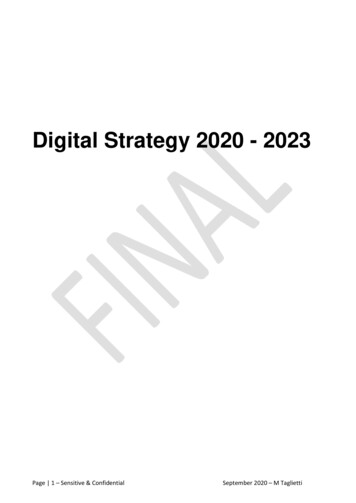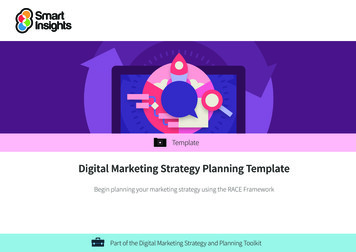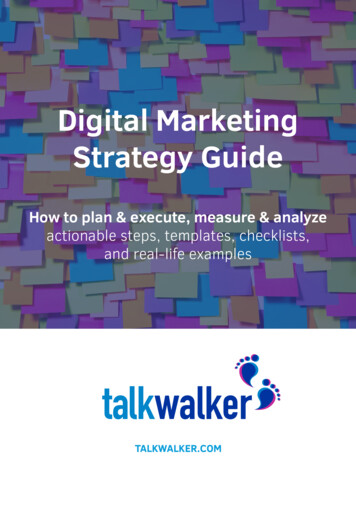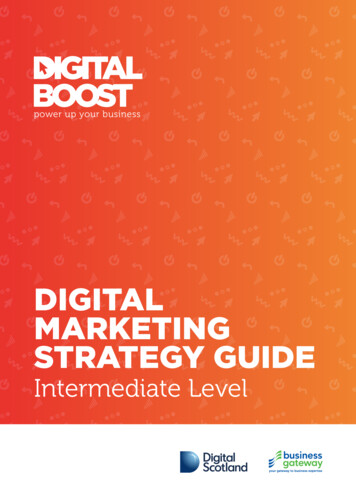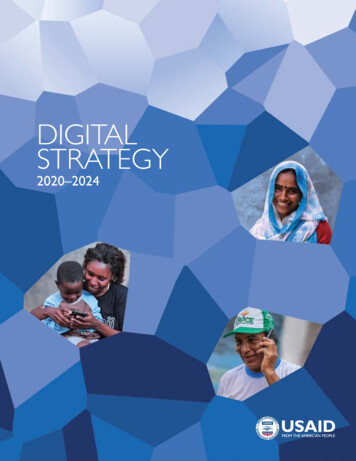
Transcription
DIGITALSTRATEGY2020–2024
Photos on cover, (clockwise): d.light; Jack Gordon, USAID; Riaz Jahanpour, USAID
ADMINISTRATOR’S MESSAGEToday, many of us take for granted our access to digital technology like smartphones and theInternet. They have become an integral part of our day-to-day lives and increasingly ourdefault way of communicating, learning, and doing business.We should remember, however, that four billion people in developing countries still do not haveaccess to the Internet, including a staggering 93 percent of households in the least-developednations. Further exacerbating the situation, the gender digital divide continues to grow. Womenare, on average, 14 percent less likely to own mobile phones than their male counterparts, and43 percent less likely to engage online.Digital technology’s profound potential is tempered by the looming threats posed byauthoritarian governments and malevolent actors who use digital tools to suppress politicaldissent and other individual freedoms while also limiting competition in the marketplace. Acrossthese two, at times incongruent, digital worlds, we must be steadfast in ensuring we do notleave behind the poor and marginalized.I am pleased to share with you the first U.S. Agency for International Development (USAID) DigitalStrategy, an Agency-wide vision for the responsible use of digital technology in development andhumanitarian work.Building on decades of leadership in digital development, the Strategy outlines USAID’sdeliberate and holistic commitment to strengthen open, inclusive, and secure digital ecosystemsin each country in which we work. These digital ecosystems are transforming how peopleworldwide gain access to information, goods, services, and opportunities; in today’s world, acountry cannot achieve self-reliance without them.The field of international development is not immune to the digital changes around us, and, asthe premier development donor, we at USAID have a responsibility—to U.S. taxpayers, to thecommunities we serve, and to ourselves—to meet the challenges and seize the opportunities ofthe digital age. This is central to USAID’s mission to end the need for foreign assistance, but wecannot do it alone. We ask our partners and colleagues around the world to engage with us.I am confident that, through collaboration, ingenuity, shared values, and collective experience,the future of our digital world will be bright for all.Ambassador Mark Andrew GreenUSAID Administrator
ACKNOWLEDGEMENTSThe USAID Digital Strategy is the result of significant contributionsfrom across USAID and our partner community, includingimplementing organizations, governments, donors, civil societyand the private sector. The Strategy would not have been possiblewithout the dedicated leadership and support of Harry Bader,Acting Executive Director for the U.S. Global Development Lab,and Gloria Steele, Acting Assistant Administrator of the Bureaufor Asia. The Strategy benefited from the guidance of ChristopherBurns, the Director for the Center for Digital Developmentin the U.S. Global Development Lab, and was the product ofcontributions made by over 130 colleagues from 19 bureaus andindependent offices and 25 missions, who participated in theStrategy’s development as members of the Working Group andAdvisory Group. The Strategy was written by a Drafting Team, ledby Aubra Anthony (U.S. Global Development Lab), with draftersfrom multiple bureaus: Adam Kaplan and Amy Malessa in theBureau for Democracy, Conflict, and Humanitarian Assistance;Paul Fekete in the Bureau for Economic Growth, Education, andEnvironment; Adele Waugaman in the Bureau for Global Health;Irena Sargsyan from the Bureau for Policy, Planning, and Learning;and John O’Bryan in the U.S. Global Development Lab.
CONTENTS01EXECUTIVE SUMMARY. 302DEVELOPMENT IN A DIGITAL AGE. 6USAID’s Vision. 7Realizing Benefits: Digital as an Enabling Force For Development.10Accounting for Risks: A Need for Safeguarding in Digital Ecosystems.13Why Digital Requires Us to Refine Our Approach to Development.2003GUIDING PRACTICES.2204STRATEGIC FRAMEWORK: FOSTERING AN INCLUSIVE DIGITAL FUTURE.25Strategic Objective 1.25Strategic Objective 2.2505CONCLUSION.3006ANNEXES.31Annex I: Detailed Strategic Framework.32Annex II: USAID Digital Strategy Implementation Initiatives.41Annex III: Glossary.48Annex IV: Principles for Digital Development.51ENDNOTES.52TABLE OF CONTENTS1
2STRATEGIC FRAMEWORK: FOSTERING AN INCLUSIVE DIGITAL FUTUREPhoto: Riaz Jahanpour, USAID
EXECUTIVE SUMMARYCountries around the world are in the midst of a historic digital transition. The rapiddevelopment and adoption of digital technology are transforming industries, governments,economies, and societies. Digital ecosystems—the stakeholders, systems, and enablingenvironments that together empower people and communities to use digital technologyto gain access to services, engage with each other, or pursue economic opportunities—hold immense potential to help people live freer, healthier, more prosperous lives. Theseecosystems can help drive economic empowerment and financial inclusion, advancenational security, support accountability and transparency in governance, introduce newand innovative health solutions, and make development and humanitarian assistance moreefficient and effective.Digital transformation comes with the risk of increasing inequality,repression, and instability. Malign actors capture digital infrastructureto advance divisive messaging, crime, and illicit finance. Despite theglobal prevalence of mobile phones and the Internet, the reality in manycommunities does not yet reflect the potential of a digital ecosystemthat drives sustainable and equitable growth. Vulnerable or marginalizedgroups often find themselves excluded from the digital ecosystem becauseof inadequate infrastructure or a lack of affordable or relevant products,services, and content; or because political, social, environmental, oreconomic factors inhibit equitable uptake.DIGITAL TECHNOLOGYIn this Strategy, we use the term“digital technology” not only todescribe a type of technology butalso to refer to the platforms,processes, and range of technologiesthat underpin modern informationand communications technologies(ICT), including the Internet andmobile-phone platforms, as well asadvanced data infrastructure andanalytic approaches.Now more than ever, as the global development community works to deliverlife-saving assistance and relay crucial information in the face of the pandemicof COVID-19, the role of digital technology is undeniable. Teachers deliverlessons remotely to homebound classes; health care workers diagnosepatients via telemedicine to minimize their risk of exposure; and peopleworldwide seek out online information about the pandemic’s impact on theirlives and livelihoods. Across all of these activities, digital technology is whatallows us to remain connected even while physical distancing requires us to be apart. It is moreimportant than ever for USAID to help communities be resilient in the face of threats likethis global pandemic, by ensuring all countries have robust digital ecosystems that are open,inclusive, secure, and of benefit to all.In light of this, The U.S. Agency for International Development (USAID) Digital Strategy(2020-2024) will position the Agency to advance our mission—to end the need forforeign assistance—through digitally supported programming that fosters the Journey toSelf-Reliance in our partner countries and maximizes the benefits, while managing the risksthat digital technology introduces into the lives of the communities we serve.EXECUTIVE SUMMARY3
GOAL OF THE USAID DIGITAL STRATEGY: To achieve and sustain open, secure, andinclusive digital ecosystems that contribute to broad-based, measurable development andhumanitarian-assistance outcomes and increase self-reliance in emerging market countries.The Digital Strategy centers around two core, mutually reinforcing objectives: Improve measurable development and humanitarian assistance outcomes through theresponsible use of digital technology in USAID’s programming; and Strengthen the openness, inclusiveness, and security of country-level digital ecosystems.DIGITAL ECOSYSTEMA “digital ecosystem” comprisesthe stakeholders, systems, andenabling environments thattogether empower peopleand communities to use digitaltechnology to gain access toservices, engage with eachother, or pursue economicopportunities. See Annex III:Glossary for examples of thecritical components of a digitalecosystem.These objectives, and USAID’s approach to achieving them, support the goalsand principles outlined in key policy documents, including the USAID PolicyFramework; the Department of State-USAID Joint Strategic Plan; and the U.S.National Cyber, National Security, and Counterterrorism Strategies.USAID will work to improve the efficiency and effectiveness of foreignassistance through the consistent and responsible use of digital technology inour development and humanitarian programming. Through our programmaticinvestments, USAID will work to strengthen the critical components of digitalecosystems that enable sustainable growth in a digital age: a sound enablingenvironment and policy commitment; robust and resilient digital infrastructure;capable digital service providers and workforce; and, ultimately, empoweredend-users of digitally enabled services.As we become a more responsive, field-oriented Agency that fosters self-reliancearound the globe, USAID must consider the capacities and commitment in thecountries where we work in order to capitalize on the opportunities and addressthe risks inherent in digital systems. USAID’s investments in country-level digitalinfrastructure and systems must lead to sustainable ownership and management by localgovernments, citizens, and the private sector. Where capacity is lacking, we can build ourpartners’ technical capabilities to oversee these systems and responsibly leverage the datathey produce to inform their own decisions. Where commitment is low, USAID can empowerand equip civil society and the private sector to navigate complex and rapidly evolvingdigital ecosystems and hold governments accountable. For communities to achieveself-reliance in the digital age, open, inclusive, and secure digital ecosystems thatpreserve and protect the rights and agency of individuals are critical. The properuse, understanding, and application of technology is a development imperative.USAID will take a multipronged approach, implemented under the leadership and authoritiesgranted to various Operating Units (OUs) within the Agency to achieve the objectives ofthe Digital Strategy. Close consultation and collaboration with governments, civil society, theprivate sector, and local communities in countries where we work will guide this approach.We will work to develop the tools and resources necessary to provide effective developmentand humanitarian assistance in a digital age; we will build capacity to better navigate the uniqueopportunities and risks that digital technology presents across USAID’s Program Cycle; wewill accelerate the transition to a default position of leveraging digital technology responsiblyand appropriately in our programming; and we will invest in our significant human capital tocontinue to build the USAID of tomorrow.4EXECUTIVE SUMMARY
USAID will work with U.S. Government interagency partners and coordinate withinteragency initiatives to implement the objectives of the Digital Strategy; address challengesand capitalize on opportunities in countries in which we work; and maximize positiveoutcomes across development, humanitarian, security, health, and human-rights efforts.Implementation of the Digital Strategy will start in a subset of target countries and extendto all USAID OUs over its five-year span. The launch of the Digital Strategy will shepherdthe creation of a Digital Learning Agenda to promote collaborative exploration of thehighest-impact pathways for inclusive, sustainable growth of digital ecosystems. Followingthe Strategy’s launch, USAID will release de
While the Digital Strategy primarily focuses on enhancing USAID’s programmatic activities, the partnership and leadership of USAID’s operational components are crucial to executing the Strategy, including the Bureau for Management (e.g., the Office of the Chief Information Officer [M/CIO] and the Office of Acquisition and Assistance [M/OAA]); the Office of Human Capital and Talent .
